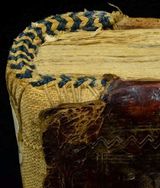Medieval bookbindings: techniques and materials - François Vinourd (course in French)
 The aim of this course is to explore different types of bookbindings on the basis of three criteria: analysis of their structure, knowledge of the materials used and their decoration. The style of the workmanship, techniques and materials are reliable means of distinguishing between different types of bookbindings. For each type of bookbinding, we will examine the origins, particularities and influences. The course will rotate around three distinct axes: 1) study of bookbinding method, so to be able to date and locate the place of production of the binding, either original or subsequent, along with a detailed presentation of the available evidence enabling the identification of original bindings; 2) explanation of different sorts of workmanship involved in the stages of making a binding, as well as a summary of the origin and the influence of the major techniques; 3) description of bookbindings: presentation of vocabulary and of IT solutions currently used to manage this data; compilation of descriptive entries.
The aim of this course is to explore different types of bookbindings on the basis of three criteria: analysis of their structure, knowledge of the materials used and their decoration. The style of the workmanship, techniques and materials are reliable means of distinguishing between different types of bookbindings. For each type of bookbinding, we will examine the origins, particularities and influences. The course will rotate around three distinct axes: 1) study of bookbinding method, so to be able to date and locate the place of production of the binding, either original or subsequent, along with a detailed presentation of the available evidence enabling the identification of original bindings; 2) explanation of different sorts of workmanship involved in the stages of making a binding, as well as a summary of the origin and the influence of the major techniques; 3) description of bookbindings: presentation of vocabulary and of IT solutions currently used to manage this data; compilation of descriptive entries.
The following types of bindings will be examined:
Non-European bindings: Special attention will be given to Byzantine/Greek bindings: historiography of the subject with specimens taken from important collections in France and abroad (BnF, Patmos, Athos, Bucharest…). Other Oriental bindings will also be examined: Coptic and Ethiopian bindings; Armenian bindings: historiography, study of Armenian manuscripts (Lyon Library), scale models, photographic documentation of examples from important collections and publications. Syriac bindings will be studied as well from examples from collections in the Middle-East and the BnF. Islamic bindings will be mentioned during the course but will not be studied in detail because this is a subject on its own. Nevertheless, we will review the current state of the question and examine a few specimens from the Lyon Library.
European bindings: The different types of Carolingian bindings will be studied in detail from bibliography and facsimiles. Bookbindings from the Late Antiquity will be examined in a similar manner along with the observation of limp bindings from the 13th-15th centuries from the Lyon Library.
Practical sessions at the Rare book department of the Lyon City Library will enable us to transform theory into practice, especially in the compilation of descriptions. Introduction to the use of instruments employed in binding study and to photographic material: portable digital microscope, watermark viewer, colour capture device (Pantone), Palmer, etc. Description of bindings for conservation and restoration projects. Acquisition of the necessary technical vocabulary and comprehension of binding structures to as to determine appropriate restoration strategies.
Presentation of the major databases on the subject.
